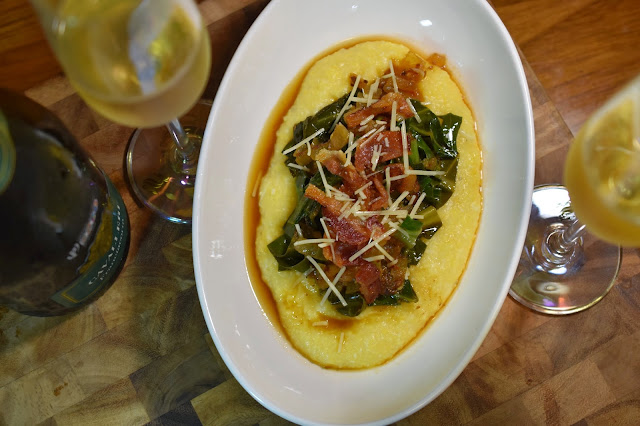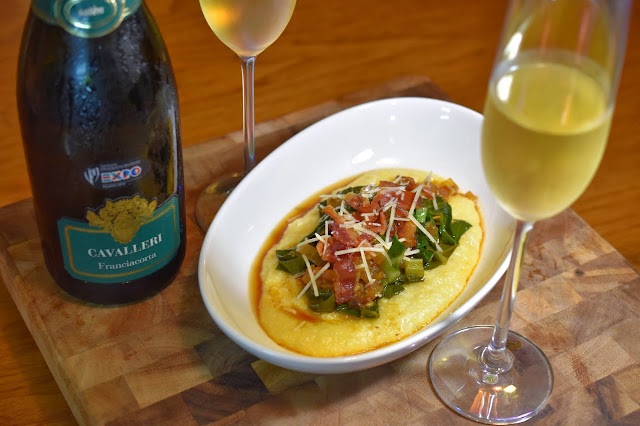Cavalleri Franciacorta with Braised Collard Greens and Polenta (#ItalianFWT)
Time for more bubbly!
Today we’re exploring a small region of Italy not enough people know about – Franciacorta. It’s understandable that this is still a fairly undiscovered gem – the region’s sparkling wine history only dates back 50-60 years. However, in that fairly short period of time, Franciacorta has established a reputation (among those who know about it) for high-quality, traditional method sparkling wine.
In addition, the area is rapidly pushing forward on the sustainability front as well. The first organic bottling of Franciacorta came out in 2002 (from Barone Pizzini), but since then they’ve progressed by leaps and bounds so that now nearly 70% of the region’s wineries are either certified organic or in the conversion process. This gives Franciacorta the highest percentage of organic producers of any region in the country.
Altogether, it’s a region well-worth getting to know.
Franciacorta Cheat Sheet
Styles: The major defining characteristic of the region is, as mentioned, that it specializes in traditional method sparkling wines – i.e. the same style as Champagne in which the second fermentation that creates the bubbles occurs in the bottle. (For an in-depth look at the process, check out this post.) The wines come in rosé and white styles and are available in the full range of sweetness levels typical of sparkling wines, ranging from Zero Dosage wines at the driest end, and demi-sec at the sweetest end. Brut is the most common style, and while up to 12 grams of sugar per liter are permitted, most producers stay well below that.
One distinctive style of Franciacorta is Satèn, which is bottled at a lower bottle pressure than the usual – it must remain below 5 atmospheres instead of 6 – creating more subtle, creamy bubbles. Satèn wines are made with only white grapes are produced exclusively in the Brut style.
Aging Requirements: Non-Vintage Franciacorta wines must age on the lees for at least 18 months. The number goes up to 30 months for vintage wines, and that’s doubled to 60 months for wines labeled Riserva. Satèn and rosé wines must age for at least 24 months on the lees.
Location: Franciacorta is located in the region of Lombardy in northern Italy. It’s bordered by Lake Iseo to the north, which helps create a warm but moderate microclimate that gives the grapes plenty of time in the sun to ripen. Cooling breezes from the foothills of the Rhaetian Alps farther to the northeast help moderate the temperatures as they flow down through the area’s rolling hills, which also help to shelter the vineyards. The growing region is shaped like an amphitheater, which was carved out by retreating glaciers. The glaciers were also kind enough to leave behind lots of well-draining, mineral-rich gravel, and limestone soils. Put it all together and you get fairly ideal conditions for growing grapes that ripen well while maintaining acidity and can grow happy and healthy in the excellent soils.
Curtefranca DOC (formerly known as Terre di Franciacorta) covers the same area, but for still white and red wines made from international varieties.
Grapes: The key grapes are similar to those used in other traditional method regions. Chardonnay, Pinot Nero (Pinot Noir), and Pinot Bianco (Pinot Blanc) are the key grapes. Chardonnay is the leader both in plantings and usage, but Pinot Bianco can make up 50% of the blend. Rosé wines must contain at least 35% Pinot Nero. Erbamat, a white grape indigenous to the area that’s enjoying a resurgence thanks to its high acidity levels, is also permitted up to 10%.
History:
While the region’s winemaking history goes back to the 16th century, its modern chapter begins in 1961 when the house of Guido Berlucchiwith released the first traditional method sparkling wine ever to be produced in the region. The wines were in high demand right away, and as a result, a string of entrepreneurs was attracted to invest in the region. The style developed quickly, and Franciacorta was granted its DOC status in 1967 for sparkling and non-sparkling wines.
The region was conscientious in how it invented itself from the start. It modeled itself closely on Champagne, and the local Consorzio established a code of self-regulation for farming and production at least as strict as its example. Franciacorta has always set the bar high for itself in terms of quality, and its Consorzio (established in 1991) has generally campaigned over time for more and more rigorous standards. As a result of all of this hard work, as well as a good bit of lobbying, Franciacorta was promoted to DOCG status (Italy’s highest classification) in 1995.
The region has established a reputation for high-quality wines that often have a good capacity for aging. (My example today had several years on it and was still quite delicious.) You’ll find a mix of large and small producers here, but they tend to share that focus on quality – which is heartening as a consumer.
What makes it distinctive:
Franciacorta might have modeled itself on Champagne, but it’s still its own region so there are distinctions. These two regions have very different climates and terroirs. Thanks to Franciacorta’s climate, they have a much easier time ripening their grapes. The fruit tends to have rounder and riper fruit notes, like golden apples and stone fruits, and even tropical fruits in warmer years. Personally, I often get a rich baked pear tart note from Franciacorta.
Thanks as well to the ripeness of their fruit, Franciacorta can pretty reliably produce good zero dosage wines every year. This isn’t always the case in Champagne.
The next difference we already talked about – this is a much younger region. Champagne has about 300 years on Franciacorta. There’s also a huge difference in scale – Champagne produces about 100 times more wine per year. However, we’ve seen as well that in Franciacorta, that smaller scale goes with attention to detail and a focus on quality.
The downside is that given the high focus on quality and smaller-scale production, bottles can definitely get pricey. However, at least you can be reasonably assured when spending the money that the wine you’re buying was conscientiously made, even if you know nothing about the producer as you're picking up the bottle. In addition, as mentioned at the top, there is an increasing focus in the region as a whole on organic and biodynamic viticulture.
The Wine & Pairing: Cavalleri Satèn Brut Franciacorta with Braised Collard Greens and Polenta
Cavalleri is one of two biodynamic estates in Franciacorta. The family’s history in the region stretches back to 1450, but it was Gian Paolo and his son Giovanni Cavalleri that began to bottle wine for themselves and gave the company its current name in 1968, shortly after the Franciacorta DOC was established. (Prior to that, the family had sold their wines in bulk.) Giovanni Cavalleri was part of the group of winemakers that helped to establish the consorzio in 1990, and he even served as President. Giovanni’s daughters, Maria and Giulia, followed them into the business, and now his grandchildren, Francesco and Diletta, have also joined the company.
Cavalleri approaches farming in a holistic way, planting grass, cruciferous plants, and legumes in between the rows to increase the organic matter within the soil and increase its vitality by natural means. The house style is to produce wines that are ripe but dry, using low levels of pressed juice, sweet dosage, and sulfur. They also partially ferment in large barrels of Slavonian oak, rather than barriques, which are more common.
I’d had the 2013 Satén in “my cellar” for a while, but it was still showing quite nicely. On the day we opened it, it showed notes of bruised golden apples and baked pears on the nose, along with dried flowers, yellow plums, and yellow peach. There were similar notes on the palate, although the fruit notes were a bit brighter and fresher. It also showed more leesy notes on the palate of pastry crust along with savory cheese rind and lots of toasty notes, perhaps coming from the age of the wine, well as the winemaking process. As it was a Satén, the bubbles were more subtle and had a creamier feel than your typical sparkler.
The pairing for this wine came out of a menu collaboration last Valentine’s Day with Dragonglass Glassware. (I’ve been meaning and trying to get this post up for A WHILE.) We paired this with a dish of braised collard greens topped with extra bacon and Parmesan. I love Serious Eats’ recipe – it’s rich and flavorful and has become my go-to method for preparing this Southern classic.
I liked the idea of serving the collards with polenta, since polenta and grits are basically the same things, I saw it as creating a bridge between the Italian wine and the Southern dish. I use Marcella Hazan’s recipe for polenta as my template, although I tend to like to add cream and/or cheese at the end.
These two made a delicious pairing. The wine became brighter and livelier with the food. The wine’s savory and umami notes, which were perhaps heightened from the wine’s age, mingled beautifully with the savory notes in the food. The wine also had a richness that matched the weight of the food but also refreshed the palate.
Geeky Details:
I couldn’t find a tech sheet for the 2013, but you can find the production details for the 2016 bottling of this wine here. The basic details for that vintage are as follows:
Fermentation and aging: 75% in steel tanks, 25% in large oak barrels.
Aging: 3 years on the lees
ABV: 12.5%
For a rundown on the many styles of Italian sparkling wines, check out this post.
And for a general overview on Italian wines, check out this post.
*****
The Aura Champagne glasses were sent to me as samples, and since then I partnered with Dragon Glassware as an ambassador. Click here to get the glasses for yourself and use the code "NICOLE10" for 10% off. (I might receive a commission at no cost to you.)
*****
The Italian Food, Wine, Travel Blogging Group (#ItalianFWT) is exploring Italian Organic & Natural Wines of Italy. I'm very late to the party, but check out the rest of their posts:
- Wendy at A Day in the Life on the Farm will share “Discovering Ziobaffa Wines”.
- Camilla at Culinary Adventures with Cam will share “With an Ethos of Quality and Sustainability: ZIOBAFFA Pinot Grigio Terre Siciliane IGT + Braised Celery Over Farro Couscous”
- Susannah at Avvinare will share “Tuscany’s Querciabella Leads the Way on Vegan Wines”
- Gwendolyn at Wine Predator will share “La Maliosa Saturnia Biodynamic Natural Wine: Red, White Native Grapes Paired with Pizza #ItalianFWT”
- Jennifer at Vino Travels will share “The Sustainability Behind Sicily’s Principi di Butera”
- Katarina at Grapevine Adventures will share “3 Wines Going From Organic To Natural”
- Franciacorta.net
- Wine Enthusiast: Discover Franciacorta, Italy’s Hidden Gem
- The Oxford Companion via JancisRobinson.com
- Wine-searcher.com
- Food & Wine: Meet Satèn, Italy's Silk Wine
- The Italy Edit: A Guide To Franciacorta, Italy’s Best Sparkling Wine Region
- Berry Bros & Rudd: Cavalleri, Lombardy
- The Wine Chef: Four Great Reasons To Discover Italy's Franciacorta Sparkling Wines







0 comments
Thanks so much for leaving your comments and questions. I always love to hear from you!